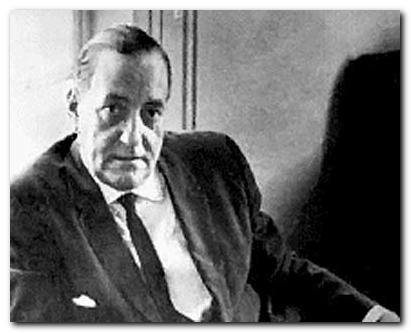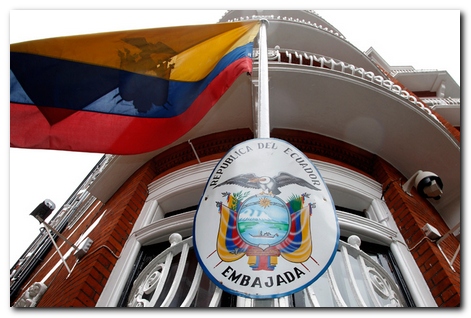tutorial, commentary, study resources, plot, and web links
Right of Sanctuary (El derecho de asilo) has a rather strange publishing history. Its first appearance was in the collection of stories Guerre de temps published in France (Paris: Gaillmard, 1967). Next it appeared in English, published by Victor Gollancz in 1970 and translated by the Bloomsbury Group diarist Frances Partridge. Only in 1972 did it appear in Spanish, published by Editorial Lumen, in Barcelona. The collection The War of Time contains a group of stories all told in radically different styles, but with a recurrent theme of exploring various notions of time and chronology.
Right of Sanctuary – critical commentary
The most unusual feature of this story is the fact that Carpentier uses all three possible narrative modes to deliver the sequence of events. The story begins in a conventional third person omniscient mode. That is, an unspecified narrator reveals information about the Secretary, his actions, and (some of) his feelings, referring to him using the third person pronoun ‘he’:
Going into his office, which was decorated in the Pompeian style, the Secretary found several dossiers that could quickly be dealt with, waiting for him beside an inkpot surmounted by a Napoleonic eagle. This task over, he passed the time until Sergeant Raton should serve his luncheon [by] walking through the Palace.
But from the next section of the story onwards, he uses a combination of first and second person narrative modes – and switches in and out of all three modes for the remainder of the story. The first person narrative mode will be familiar to most readers – a sequences of events related from the point of view of a specific character – in this case the Secretary himself, who refers to himself as ‘I’:
I’m bored. I’m bored. I’m bored. And I’m surrounded by things that contribute some new elements to my boredom.
But the second person narrative mode is likely to be less familiar. This takes the form of ‘you’ being used as the form of address – and that ‘you’ can be thought of as singular or plural. It can be the individual ‘I’ of the first person narrative mode, speaking about himself; or it can be either the first person narrator or the author addressing the reader – as if saying ‘this is what you would do in these circumstances’:
You take advantage of the momentary respite to leave the bar and hurry off to the offices of the National City Bank of New York, which is crowded with people quite unaware of what is going on fifty yards away. You take the next street and plunge into the old part of town, where you know no one.
This mixture of narrative modes seems to create a distance between the author and his work. The reader is being invited to contemplate a series of tableaux vivants rather than become engaged psychologically and emotionally with the characters and their predicaments. But this is entirely consistent with Carpentier’s general approach to fiction, which does not follow the norms of traditional European literature
The story is a slightly improbable jeu d’esprit, but strangely enough it has a close link to historical reality – because Alejo Carpentier, having been a political exile from Cuba during the Batista regime, was actually made Cuban ambassador to France in 1966 by Fidel Castro. It is worth noting that this is only twelve months before the story was first published. Carpentier even draws attention to this strange phenomenon during the course of the story:
the Consul told me that in his country—’our’ country—the position of Ambassador was not generally given to a professional diplomat, but to brilliant or able men: writers, financiers, men of the world, journalists. Moreover, it was an American tradition to appoint men from other nations of the continent to diplomatic and educational posts
This might even be considered Alejo Carpentier obliquely patting himself on the back, or it could alternatively be seen as the ‘real’ part in ‘lo real maravilloso’ – a term he coined to describe the type of literature which emerged from Latin-America in the wake of the modernist movement of the 1920s and 1930s.
The story also embraces one of Carpentier’s favourite conceits – the idea of circularity, or things returning to their original state – but maybe in a changed form. At the beginning of the story, the Secretary (whose name is Ricardo – which is only mentioned once) is working for the Ambassador of an un-named country. The embassy is located in what seems like a Latin-American state which is in the grip of a military coup. To escape danger, the Secretary seeks asylum in the embassy of another small Latin-American country. As a result of his knowledge of the country’s history he is appointed its Ambassador – replacing the diplomatic incumbent, who is incompetent.
This neat irony is underscored when he goes to present his credentials to General Mabillan, who knows who he is, appreciates the ironic political twist, and shields him from possible negative publicity. As the story closes, the Secretary returns to more or less the same work (but in a different Embassy) and he returns to a normal sense of time, having been ‘outside’ it during his period of refuge.
Right of Sanctuary – study resources
Right to Sanctuary is one of five stories contained in the collection The War of Time. The other four stories are Journey Back to the Source (1944), The Road to Santiago (1948), Like the Night (1947), and The Wise Men (1967).
![]() Right to Sanctuary – at Amazon UK – (text in English)
Right to Sanctuary – at Amazon UK – (text in English)
![]() El derecho de asilo – at Amazon UK – (Text in Spanish)
El derecho de asilo – at Amazon UK – (Text in Spanish)
![]() Right to Sanctuary – at Amazon US – (Text in English)
Right to Sanctuary – at Amazon US – (Text in English)
![]() El derecho de asilo – at Amazon US – (Text in Spanish)
El derecho de asilo – at Amazon US – (Text in Spanish)
Right of Sanctuary – plot summary
Part 1. On a Sunday some time in the early 1940s, in the lavish and empty rooms of a government Palace, the Secretary to the President hears rumours of a possible military coup d’etat . He shares the news with Sergeant Raton, a mild-mannered adjutant who is a fan of Clausewitz and his theory of Total War. The country is in a border dispute with an adjacent state.
Part 2. Next day the Secretary arrives at the Palace to find government ministers being arrested. When the President himself arrives for a cabinet meeting there is an exchange of gunshots. The Secretary escapes from the building and takes refuge in the embassy of a small Latin-American country. The foreign Ambassador is reluctant to have him, but his wife is more hospitable. The rebel General Mabillan makes a patriotic broadcast, but the Secretary foresees nothing but potential corruption in all his declared new public works.
Part 3. Some days later the Secretary has become bored, cooped up in a small spare bedroom in the foreign embassy. He passes time itemising the contents of a hardware store in the street outside his window.
Part 4. The frontier dispute intensifies, and General Mabillan makes further patriotic broadcasts on radio and television. He organises a display of anti-aircraft defence forces which does nothing but injure his own population. The Secretary studies the history of the Frontier Country in its post-Colombian development, and comes up with an ambiguous compromise solution to the border dispute
Part 5. After some months the Secretary more or less takes over the business of the foreign Embassy, enhances its trade in folkloric merchandise, and becomes the lover of the Ambassador’s wife, Cecilia.
Part 6. The Secretary loses track of time, whilst in the streets below riots erupt against General Mabillan. Meanwhile, he and Cecilia plan to poison the Ambassador.
Part 7. The Secretary is eventually granted nationality by his host country, and because of his efficiency he is made Ambassador by the visiting Consul, to replace his incompetent host, who has been recalled and posted to Gothenburg. The Secretary presents himself formally to General Mabillan, who is aware of the diplomatic trick. Next day the Secretary, now Ambassador, returns to work and resumes a normal relationship with time.

Alejo Carpentier web links
Carpentier at Wikipedia
Background, biography, magical realism, major works, literary style, further reading
Carpentier at Amazon UK
Novels, criticism, and interviews – in Spanish and English
The Kingdom of this World
Lecture by Rod Marsh – University of Cambridge
Carpentier at Internet Movie Database
Films and TV movies made from his novels
Carpentier in Depth
Spanish video documentary and interview with Carpentier (1977)
© Roy Johnson 2015
More on Alejo Carpentier
More on the novella
More on literary studies
More on short stories
